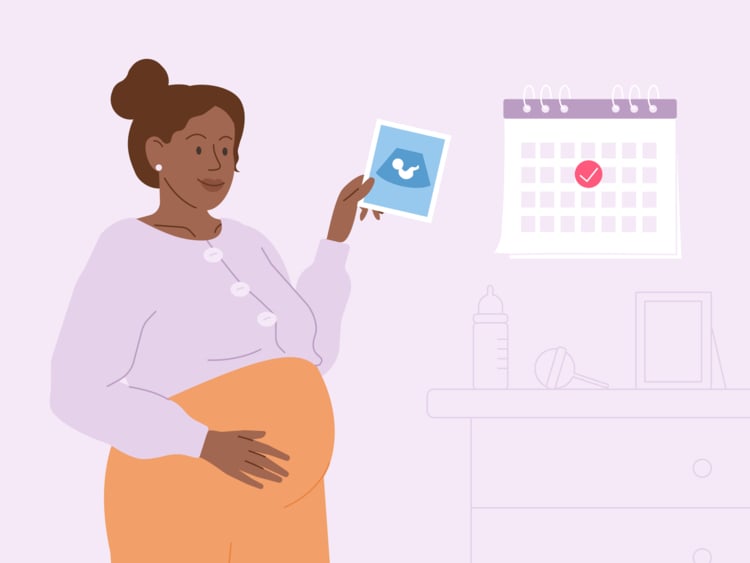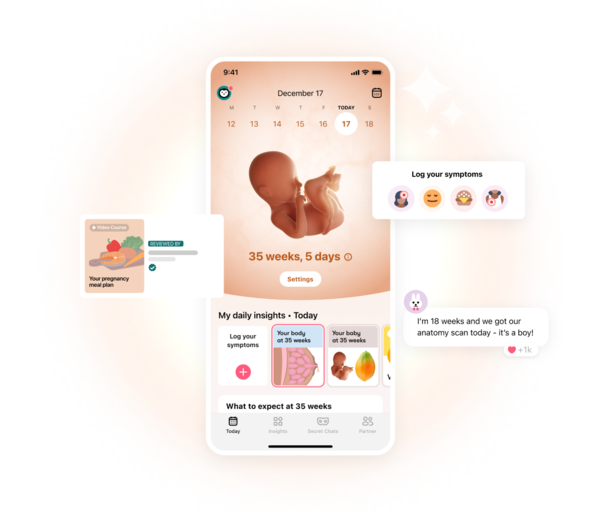Gestational age is one way your doctor will describe how far along you are. Here’s everything you need to know.
-
Tracking cycle
-
Getting pregnant
-
Pregnancy
-
Help Center
-
Flo for Partners
-
Anonymous Mode
-
Flo app reviews
-
Flo Premium New
-
Secret Chats New
-
Symptom Checker New
-
Your cycle
-
Health 360°
-
Getting pregnant
-
Pregnancy
-
Being a mom
-
LGBTQ+
-
Quizzes
-
Ovulation calculator
-
hCG calculator
-
Pregnancy test calculator
-
Menstrual cycle calculator
-
Period calculator
-
Implantation calculator
-
Pregnancy weeks to months calculator
-
Pregnancy due date calculator
-
IVF and FET due date calculator
-
Due date calculator by ultrasound
-
Medical Affairs
-
Science & Research
-
Pass It On Project New
-
Privacy Portal
-
Press Center
-
Flo Accuracy
-
Careers
-
Contact Us
Gestational age: How do you count pregnancy weeks?


Every piece of content at Flo Health adheres to the highest editorial standards for language, style, and medical accuracy. To learn what we do to deliver the best health and lifestyle insights to you, check out our content review principles.
Key takeaways
- Gestation describes the time between conception and birth — or how far along in your pregnancy you are.
- Gestational age is measured in weeks, from the first day of your last period to the current date.
- If you underwent in vitro fertilization, gestational age can be calculated from the date of embryo transfer and the age of your embryo.
- Gestational age can help your doctor provide the best prenatal care for you and your baby and monitor your baby's development.
- There’s a difference between gestational age and fetal age. Gestational age is how far along you are, while fetal age refers to the age of the fetus — usually two weeks apart.
What is gestational age?
From Braxton Hicks and fundus to crowning and colostrum, it can feel like you have to learn a whole new language once you’re pregnant. One of the terms you may have heard your health care provider use is “gestational age.” This describes how many weeks pregnant you are, usually from the first day of your last menstrual period to the current date.
Your due date is after 40 weeks’ gestation. If your baby is born between 39 weeks and 40 weeks and 6 days, then you’re considered full term. If you deliver between 37 weeks and 38 weeks and 6 days, then you’re considered to be early term. And if you deliver before 37 weeks, then you’re considered to be preterm. You might have used a due date calculator to predict how far along you are, but your doctor will also establish your gestational age to help predict your due date and monitor your pregnancy and your baby’s development.
If you're using an app like Flo for pregnancy, you can find out what changes you might expect as you follow your baby's growth week-by-week. You can also read personal stories from other parents-to-be using our Secret Chats feature.
Understanding gestational age
Gestational age is usually calculated from the first day of your last period or your due date to the current date. Your due date is established early in your pregnancy using the date of your last menstrual period and ultrasound. This can feel like a major milestone for many parents. Before ultrasounds and ovulation tracking could be used, your period was the most obvious marker of a cycle. Once your due date has been established, your doctor may use it to establish your gestational age. How’s that for some pregnancy math?
It can be difficult to track your pregnancy from the day you ovulated or the day you conceived. Unless you were actively monitoring ovulation, you’re unlikely to know exactly when you got pregnant. Even if you only had sex once during your fertile window (the six days in the month around ovulation when you’re most likely to get pregnant), there’s still a chance that you didn’t conceive on that day because sperm can live in your body for up to five days. It can be a tricky business.
So, your health care provider will use information about your cycle and periods in addition to an ultrasound to work out your gestational age. While it can be slightly different from person to person, the average menstrual cycle length is between 21 and 35 days, and the first day of a new period marks the first day of a new menstrual cycle. Ovulation (when one of your ovaries releases an egg) generally happens around 14 days before your expected period, but the exact day this happens can vary from cycle to cycle. This can be around two weeks after the first day of your last period. This is why gestational age and fetal age are around two weeks apart, since gestational age takes into account the two weeks before ovulation and possible conception.
Why is it important?
Knowing how far along you are in your pregnancy ensures that you and your baby get the proper medical care at the right time. It also helps doctors understand if your baby is born prematurely or if you’re past your due date, which is essential for delivery and postpartum care.
Understanding your gestational age and fetal age (more on that below) is especially important for following your baby’s growth and development so you and your health care team can track important milestones, decide which prenatal tests to take, and prevent potential pregnancy complications. A pregnancy tracking app like Flo can help you to keep on top of where you are in your pregnancy.
Take a quiz
Find out what you can do with our Health Assistant

Drawbacks of predicting your due date with gestational age
Predicting when a baby will be born isn’t as straightforward as you’d think. The due date given by health care providers is only an estimate, and only 1 in 20 people give birth on their estimated due date.
Gestational age can give you a general idea of when you might give birth, but your baby could arrive early or late, or the calculations may be slightly off by a week. A 1st-trimester ultrasound usually determines the most accurate due date, but even this is just an estimate. The due date might be less precise if the ultrasound takes place later in your 2nd trimester. As your pregnancy progresses, ultrasounds become increasingly unreliable at accurately predicting your due date. If you have a due date ultrasound between 14 and 22 weeks, then there’s a risk that the date could be off by around seven to 10 days. From 22 to 28 weeks, this risk rises to being off by 10 to 14 days. Dating after 28 weeks (your 3rd trimester) is the least reliable time, as accuracy could be off by 21 to 30 days.
Gestational age vs. fetal age
Fetal age is different from gestational age. While gestational age measures how far along a pregnancy is in weeks, fetal age is the age of the growing fetus. Fetal age can be slightly harder to calculate, as it usually uses the date you may have conceived.
Estimated due date
To estimate your due date, your doctor will look at the date of your last period and first ultrasound. They’ll generally add 280 days (or 40 weeks) to the date of your last period, compare it with the first ultrasound, and find the estimated due date. As mentioned above, your estimated due date is only a rough idea as to when you might deliver.
Gestational age and IVF
In vitro fertilization (IVF) is a fertility treatment where an egg is fertilized by sperm in a lab to create embryos. Those embryos are then transferred back into a person’s uterus to help them get pregnant.
Since IVF differs from spontaneous conception (when you get pregnant through sex), calculating your gestational age, due date, and fetal age after IVF is slightly different. Your due date can be determined by the day the embryo was transferred into your uterus and the age of the embryo at the point of transfer. The transfer is scheduled for a specific date, so the calculation of your due date is pretty accurate. The embryo may not implant in the wall of your uterus on the same day as your transfer, but it may do so within a few days.
There are several formulas that an IVF due date calculator can use, depending on what type of IVF you have:
- Add 266 days (or 38 weeks) to the egg extraction or fertilization date if fresh eggs are used.
- Add 263 days to the embryo transfer date if 3-day-old frozen embryos are used.
- If the frozen embryo is 5 days old, add 261 days to the embryo transfer date.
More FAQs
Do doctors go by gestational age or fetal age?
As mentioned above, gestational age is how far along you are, while fetal age refers to the age of your baby — usually two weeks apart. While your doctor will use your gestational age to determine the type of care, monitoring, and tests you may need, medically, fetal age isn’t something that’s looked at or used at all.
How accurate is gestational age?
Determining gestational age can be tricky. Ultrasound is the most accurate method of determining gestational age, although even then, it may not be a perfect match to your delivery date. If you have undergone IVF, determining gestational age is much easier since you know the exact date of conception (embryo transfer).
Why do doctors add two weeks to pregnancy?
Doctors add two weeks to pregnancy because pregnancy is counted from the first day of your last period, not the date of conception, which generally happens two weeks later. And most people realize they’re pregnant a few weeks after their first missed period, so this makes dating more accurate.


Hey, I'm Anique
I started using Flo app to track my period and ovulation because we wanted to have a baby.


The Flo app helped me learn about my body and spot ovulation signs during our conception journey.


I vividly
remember the day
that we switched
Flo into
Pregnancy Mode — it was
such a special
moment.
Real stories, real results
Learn how the Flo app became an amazing cheerleader for us on our conception journey.
References
“Calculating a Due Date.” Johns Hopkins Medicine, www.hopkinsmedicine.org/health/wellness-and-prevention/calculating-a-due-date. Accessed 5 Oct. 2023.
“Committee Opinion No 700: Methods for Estimating the Due Date.” Obstetrics and Gynecology, vol. 129, no. 5, May 2017, pp. E150–54, https://doi.org/10.1097/aog.0000000000002046.
“Fetal Development.” Cleveland Clinic, my.clevelandclinic.org/health/articles/7247-fetal-development-stages-of-growth. Accessed 4 Oct. 2023.
“Gestational Age.” MedlinePlus, medlineplus.gov/ency/article/002367.htm. Accessed 4 Oct. 2023.
“How Can I Tell When I’m Ovulating?” NHS, www.nhs.uk/common-health-questions/sexual-health/how-can-i-tell-when-i-am-ovulating/. Accessed 5 Oct. 2023.
“How Your Fetus Grows during Pregnancy.” The American College of Obstetricians and Gynecologists, Aug. 2020, www.acog.org/womens-health/faqs/how-your-fetus-grows-during-pregnancy.
“In Vitro Fertilization (IVF).” Mayo Clinic, 1 Sep. 2023, www.mayoclinic.org/tests-procedures/in-vitro-fertilization/about/pac-20384716.
Jensen, Ashley, and Jane Wrede. “Fertility Awareness-Based Methods for Family Planning: A Literature Review.” Journal of Christian Nursing, vol. 37, no. 4, Oct./Dec. 2020, pp. E47–48, https://doi.org/10.1097/cnj.0000000000000758.
“Menstrual Cycle: What’s Normal, What’s Not.” Mayo Clinic, 22 Apr. 2023, www.mayoclinic.org/healthy-lifestyle/womens-health/in-depth/menstrual-cycle/art-20047186.
“Methods for Estimating the Due Date.” The American College of Obstetricians and Gynecologists, May 2017, www.acog.org/clinical/clinical-guidance/committee-opinion/articles/2017/05/methods-for-estimating-the-due-date.
Morgan, John A., and Danielle B. Cooper. “Pregnancy Dating.” StatPearls. StatPearls Publishing, 2022, www.ncbi.nlm.nih.gov/books/NBK442018/.
Naidu, Krelin, and Katherine L. Fredlund. “Gestational Age Assessment.” StatPearls. StatPearls Publishing, 2023, www.ncbi.nlm.nih.gov/books/NBK526000/.
Nicholson, James M., et al. “New Definition of Term Pregnancy.” JAMA, vol. 310, no. 18, 13 Nov. 2013, pp. 1985–86, doi:10.1001/jama.2013.277993.
“Pregnancy and Birth: When Your Baby’s Due Date Has Passed.” InformedHealth.org. Institute for Quality and Efficiency in Health Care, 2018, www.ncbi.nlm.nih.gov/books/NBK279571/.
“Pregnancy Due Date and Gestational Age Calculator.” Perinatology.com, perinatology.com/calculators/Due-Date.htm. Accessed 4 Oct. 2023.
Quinn, Julie-Anne, et al. “Preterm Birth: Case Definition & Guidelines for Data Collection, Analysis, and Presentation of Immunisation Safety Data.” Vaccine, vol. 34, no. 49, Dec. 2016, pp. 6047–56, https://doi.org/10.1016/j.vaccine.2016.03.045.
“Screening Tests in Pregnancy.” NHS, www.nhs.uk/pregnancy/your-pregnancy-care/screening-tests/. Accessed 5 Oct. 2023.
“Sperm: How Long Do They Live after Ejaculation?” Mayo Clinic, 5 May 2022, www.mayoclinic.org/healthy-lifestyle/getting-pregnant/expert-answers/pregnancy/faq-20058504.
History of updates
Current version (24 November 2023)
Published (29 June 2019)
In this article

Get your personal guide to pregnancy with the Flo app
-
Follow your baby's growth week by week
-
Get expert info on symptoms, safe foods, and more
-
Chat with other parents-to-be




